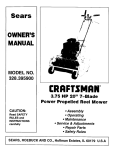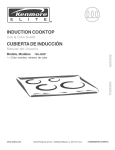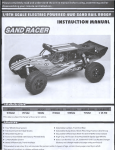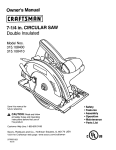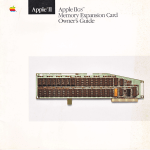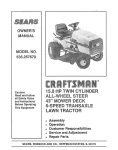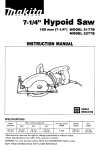Download Milwaukee 6470-21 Use and Care Manual
Transcript
OPERATOR'S MANUAL
MANUEL de L'UTILISATEUR
MANUAL del O P E R A D O R
••'•." "•Nb-de cat.-,
6470-21
10%" CIRCULAR SAW
SCIE CIRCULAIRE 260 mm (10%")
SIERRA CIRCULAR DE 260 mm (10%")
TO REDUCE THE RISK OF INJURY, USER MUST READ OPERATOR'S MANUAL
AFIN DE REDUIRE LE RISQUE DE BLESSURES,
L'UTILISATEUR.
L'UTILISATEUR DOIT LIRE LE MANUEL DE
PARA REDUCIR EL RIESGO DE LESIONES, EL USUARIO DEBE LEER EL MANUAL DEL
OPERADOR.
,
.
GENERAL
POWER
TOOL
SAFETY
WARNINGS
ML WARNING READ ALL SAFETY WARNINGS AND ALL INSTRUCTIONS. Failure to
follow the warnings and Instructions may result in electric shock, fire and/or serious injury. Save
all warnings and instructions for future reference. The term "power tool" in the warnings refers to your mains-operated (corded) power tool or battery-operated (cordless) power tool.
WORK AREA
SAFETY
•Keep work area clean and well lit. Cluttered or
dark areas invite accidents.
•Do not operate power tools in explosive atmospheres, such as in the presence of flammable
liquids, gases or dust. Power tools create sparks
which may ignite the dust or fumes.
•Keep children and bystanders away while operating a power tool. Distractions can cause you to
lose control.
I
ELECTRICAL
SAFETY
I
•Power tool plugs must match the outlet. Never
modify the piug in any way. Do not use any
adapter plugs with earthed (grounded) power
tools. Unmodified plugs and matching outlets will
reduce risk of electric shock.
•Avoid body contact with earthed or grounded
surfaces such as pipes, radiators, ranges and
refrigerators. There is an increased risk of electric
shock if your body is earthed or grounded.
•Do not expose power tools to rain or wet conditions. Water entering a power tool will increase the
risk of electric shock.'
•Do not abuse the cord. Never use the cord for
carrying, pulling or unplugging the power tooi.
Keep cord away from heat, oil, sharp edges
or moving parts. Damaged or entangled cords
increase the risk of electric shock.
•When operating a power tool outdoors, use an
extension cord suitable for outdoor use. Use of
a cord suitable for outdoor use reduces the risk of
electric shock.
•If operating a power tool in a damp iocation is
unavoidable, use a ground fault circuit interrupter (GFCi) protected supply. Use of an GFCi
reduces the risk of electric shock.
result in personal injury.
•Do not overreach. Keep proper footing and baiance at all times. This enables better control of the
power tool in unexpected situations.
•Dress properly. Do not wear loose clothing or
jewellery. Keep your hair, clothing and gloves
away from moving parts. Loose clothes, jewellery
or long hair can be caught in moving parts.
•If devices are provided for the connection of
dust extraction and coliection facilities, ensure
these are connected and property used. Use of
dust collection can reduce dust-related hazards.
I
POWER TOOL USE AND CARE
~]
•Do not force the power tool. Use the correct
power tooi for your application. The correct power
tooi will do the job better and safer at the rate for
which it was designed.
•Do not use the power tool If the switch does not
turn it on and off. Any power tooi that cannot be
controlled with the switch is dangerous and must be
repaired.
•Disconnect the piug from the power source and/
or the battery pack from the power tool before
making any adjustments, changing accessories,
or storing power toois. Such preventive safety
measures reduce the risk of starting the power tool
accidentally.
•Store idle power toois out of the reach of children and do not allow persons unfamiliar with
the power tooi or these instructions to operate
the power tooi. Power tools are dangerous in the
hands of untrained users;
•Maintain power toois. Check for misalignment or
binding of moving parts, breakage of parts and
any other condition that may affect the power
tool's operation, if damaged, have the power tooi
repaired before use. Many accidents are caused
by poorly maintained power tools.
•Keep cutting tools sharp and clean. Properly
maintained cutting tools with sharp cutting edges
are less likely to bind and are easier to control.
•Use the power tooi, accessories and tool bits
etc. in accordance with these instructions, taking into account the working conditions and the
work to be performed. Use of the power tool for
operations different from those intended couid result
in a hazardous situation. •
I
^'SERVICE
I
•Have your power tool serviced by a qualified
repair person using only identical replacement
parts. This will ensure that the safety of the power
tool is maintained.
' • •
I
PERSONAL
SAFETY
I
•Stay alert, watch what you are doing and use
common sense when operating a power tool. Do
not use a power tool while you are tired or under
the influence of drugs, alcohol or medication. A
moment of inattention while operating power tools
may result in serious personal injury.
•Use personal protective equipment. Always
wear eye protection. Protective equipment such
as dust mask, non-skid safety shoes, hard hat, or
hearing protection used for appropriate conditions
will reduce personal injuries. • ' - - '
•Prevent unintentional starting. Ensure the
switch is in the off-position before connecting
to power source and/or battery pack, picking
up or carrying the tooi. Carrying power tools with
SPECIFIC
SAFETYRUL^~~]
your finger on the switch or energising power tools {
that have the switch on invites accidents.
Cutting procedures
•Remove any adjusting key or wrench before •ADANGER: Keep hands away from cutting
turning the power tooi on. A wrench or a key left
area and the blade. Keep your second hand on
attached to a rotating part of the power tool may
auxiliary handle, or motor housing. If both hands
are holding the saw, they cannot be cut by the blade.
•Do not reach underneath the workplace. The
guard cannot protect you from the blade below the
workpiece. ..n: ,.
•Adjust the cutting depth to the thickness of the
workpiece. Less than a full tooth of the blade teeth
should be visible below the workpiece. : I ' l r
•Never, hold piece being cut in your hands or
across your leg. Secure the workpiece to a stable
platform, it is important to support the work properly
to minimize body exposure, blade binding, or loss
of control.
rv.
/..J
•Hold the power tool by Insulated.gripping surfaces only, when performing an operation where
the cutting tooi may contact hidden wiring or its
own cord. Contact with a "live" wire will also make
exposed metal parts of the power tool "live" and
could give the operator an eiectric shock. ;
•When ripping, always use a rip fence or straight
edge guide. This improves the accuracy of cut and
reduces the chance of blade binding.'
-'
•Always use blades with correct size and shape
(diamond versus round) of arbour holes; Blades
that do not match the mounting hardware of the saw
will run eccentrically, causing loss of control.
•Never use damaged or incorrect blade washers
or bolt. The blade washers and bolt were specially
designed for your saw, for optimum performance
and safety of o p e r a t i o n . • '
'
Further safety instructions for ail saws
Kickback causes and related warnings
- Kickback is a sudden reaction to a pinched, bound
or misaligned saw blade, causing an uncontrolled
saw to lift up and out of the workpiece toward the
operator; "
- When the blade is pinched or bound tightly by the
kerf closing down, the blade stalls and the motor
reaction drives the unit rapidly back toward the
operator;
.,:
- If the blade becomes twisted or misaligned in the
cut, the teeth at the back edge of the blade can dig
into the top surface of the wood causing the blade
; to climb out of the kerf and jump back toward the
•'operator "' "
,
,r.:_;
•
Kickback is the result of saw misuse and/or incorrect operating procedures or conditions and can be
avoided by taking proper precautions as given below:
•Maintain a firm grip with both hands on the saw
and position your arms to resist kickback forces.
Position your body to either side of the blade, but
not in line with the blade. Kickback could cause
the saw to jump backwards, but kickback forces can
be controlled by the operator, if proper precautions
are taken.
•When blade is binding, or when interrupting a
cut for any reason, release the trigger and hoid
the saw motionless in the materiai untii the
blade comes to a complete stop. Never attempt
to remove the saw from the work or pull the saw
backward while the blade Is In motion or kickback may occur, investigate and take corrective
actions to eliminate the cause of blade binding.
•When restarting a saw in the workpiece, centre
the saw blade in the kerf and check that saw
teeth are not engaged into the material. If saw
3
blade is binding, it may walk up or kickback from the
workpiece as the saw is restarted.
•Support large panels to minimise the risk of
blade pinching and kickback. Large panels tend
to sag'under their own weight. Supports must be
placed under the panel on both sides, near the line
of cut and near the edge of the panel.
•Do not use dull or damaged blades. Unsharpened
or improperly set blades produce narrow kerf causing excessive friction, blade binding and kickback.
•Blade depth and bevel adjusting locking levers
must be tight and secure before making cut. If
blade adjustment shifts while cutting, it may cause
binding and kickback.
,• '« - ? . J .
•Use extra caution when sawing into existing
wails or other blind areas. The protruding blade
may cut objects that can cause kickback. •
' • -'
Lower guard function ' -j ''
, ' '
•Check lower guard for proper'closing before
each use. Do not operate the savir if lower guard
does not move freely and close instantly. Never
clamp or tie the lower guard into the open position, f saw is accidentaliy dropped, lower guard may,
be bent; Raise the lower guard with the retracting
handle and make sure it moves freely and does not
touch the blade or any other part, in all angles and
depths of cut:'
,;^-' ; ,' , '
•Check the operation of the lower guard spring,
if the guard and the spring are not operating
properly, they must be serviced before use.
Lower guard may operate sluggishly due to damaged parts, gummy deposits, ora build-up of debris:
•Lower guard should be retracted manually only
for special cuts such as "plunge cuts" and
"compound cuts." Raise lower guard by retracting
handle and as soon as blade enters the material,' the
lower guard must be released. For all other sawing,'
the lower guard should operate automatically.
•Always observe that the lower guard is covering
the blade before placing saw down on bench or
floor.,An unprotected, coasting blade will cause
the saw to waik backwards, cutting vyhatever is in
its path. Be aware of the time it takes for the blade
to stop after switch is released. . •, , ;.
, ',
•Maintain labels and hamepiates. These carry
important Information. If unreadable or missing,
contact a M/LIVAL/K££,service facility for a free
replacement; '
-"-i
_.'., ,->'i- '
•WARNING Some dust created by power sanding,
sawing, grinding, drilling, and other construction
activities contains chemicals known to cause cancer, birth defects or other reproductive harm. Some
examples of these chemicals are:
•lead from lead-based paint
•crystalline silica from bricks and cement and other
masonry products, and
•arsenic and chromium from chemically-treated
lumber.
Your risk from these exposures varies, depending
on how often you do this type of work. To reduce
your exposure to these chemicals: work in a well
ventilated area, and work with approved safety
equipment, such as those dust masks that are specially designed to filter out microscopic particles.
EXTENSION
GROUNDING
MLWARNING
Improperly connecting the
grounding wire can result in the risk of electric
shock. Check with a qualified electrician if you
are in doubt as to whether the outlet is properly
grounded. Do not modify the plug provided
with the tool. Never remove the grounding
prong from the plug. Do not use the tool if the
cord or plug is damaged. If damaged, have It
repaired by a MILWAUKEE service facility before use. If the piug will not fit the outlet, have a
proper outlet installed by a qualified electrician.
Grounded Tools:
Tools with Three Prong Plugs
Tools marked "Grounding Required" have a three
wire cord and three prong grounding plug. The
plug must be connected to a properly grounded
outlet (See Figure A). If the tool should electrically
malfunction or break down, grounding provides a
low, resistance path to carry electricity away from
the user, reducing the risk of electric shock.
The grounding prong in the plug is connected
through the green wire inside the cord to the
grounding system in the tooi. The green wire in the
cord must be the only wire connected to the tool's
grounding system and must never be attached to
an electrical y "live" terminal.
Your tool must be plugged into
an appropriate outlet, properly
installed and grounded in accordance with ail codes and
ordinances. The piug and
outlet should look like those
Fig. A
in Figure A.
Guidelines for Using Extension Cords
• if you are using an extension cord outdoors,
be sure it is marked with the suffix "W-A" ("W"
in Canada) to indicate that it is acceptable for
outdoor use.
• Be sure your extension cord is properly wired
and in good electrical condition. Always replace
a damaged extension cord or have it repaired by
a qualified person before using it.
• Protect your extension cords from sharp objects,
excessive heat and damp or wet areas.
. •,;
Recommended Minimum Wire Gauge
For Extension Cords*
Extension Cord Length
Nameplate Amps 25'
50'
75' 100' 150'
0-2.0
18
18
18
18
16
2.1 - 3.4
18
18 ' 18
16
14
3.5-5.0
18 •18
16
14
12
5.1 - 7.0
18
16
14
12
12
7.1-12.0
16
14
12
10^
12.1-16.0
14
12
10
16.1-20.0
12
10
' Based on limiting the line voltage drop to five volts at
150% of the rated amperes.
,,
. .
Double Insulated Tools:
Tools with Two Prong Plugs
Toois marked "Double insulated" do not require
grounding. They have a special double insulation
system which satisfies OSHA requirements and
compiles with the applicable standards of Underwriters Laboratories, Inc., the
Canadian Standard Association and the National Electrical Code. Double insulated
tools may be used in either of
the 120 volt outlets shown in .
Figures B and C. -
::
CORDS
FUNCTIONAL
Grounded tools require a three wire extension
cord. Double insulated tools can use either a two
or three wire extension cord. As the distance from
the supply outlet increases, you must use a heavier
gauge extension cord. Using extension cords with
inadequately sized wire causes a serious drop in
voltage, resulting in loss of power and possible tool
damage. Refer to the table shown to determine the
required minimum wire size.
.. • • 'r .•
The smaller the gauge number of the wire; the
greater the capacity of the cord. For example, a 14
gauge cord can carry a higher current than a 16
gauge cord. When using more than one extension
cord to make up the total length, be sure each cord
contains at least the minimum wire size required.
If you are using one extension cord for more than
one tool, add the nameplate amperes and use the
sum to determine the required minimum wire size.
READ AND SAVE ALL
INSTRUCTIONS FOR FUTURE USE.
11; 60" Override button
•'12. Miter scaie ''
13. Miter adjusting lever
14. Spindle lock button
15. Upper guard •
16. Depth of cut scale
17. Depth adjusting lever
'18. Wrench storage
,1.,
2.
3.
4.
5.
Auxiliary handie
Motor housing
Trigger switch
Lowerguardlever
Lower guard
6..- Blade bolt
7. Outer flange
8. ' Rip fence slot
'9. Sigtiting notches
10. Shoe
SPECIFICATIONS
Cat. No.
6470-21
m
V
Volts
No Load Blade
AC
Amps
RPM.
Size Arbor
120
•15 • •. 5200
10%" : 5/8"
Double Insulated
Volts
A
•
Poxxxxmin;'
c(E)us
Alternating Current
Max Cutting Max Cutting
Depth at 45' Depth at 60'
0 to 2-3/4" ; 0 to 1-3/4"
Amps
No Load Revolutions per. Minute
(RPM)
.:
,;
Underwriters Laboratories, inc.
United States and Canada '
ASSEMBLY
MkWARNING Only use accessories with
maximum speed rating at least as high as
nameplate RPM of tool.
4
Max Cutting
Depth at 90*
0 to 3-13/16"
SYMBOLOGY
Mk. WARNING To reduce the risk of Injury,
always unplug tool before changing or removing accessories. Only use accessories specifically recommended for this tool. Others may
be hazardous.
, Fig. B- Fig. C
DESCRIPTION
Selecting Blade
, if /i :
Seiect.a blade appropriate for your application.
Refer to the "Accessories" section for a list of biades
to be used for the proper applications of this tooi.
Always use sharp biades. Dull biades tend to
overload the tool and increase the chance of KICKBACK. Only use thin kerf blades with a maximum
safe operating speed greater than the no load RPM
marked on the tool's nameplate. Read the blade
manufacturer's instructions before use. Do not use
any type of abrasive cut-off wheel or dry diamond
cutting biades. Use the correct blade type for your
application. Using the wrong blade may result in
reduced performance or damage to the blade. Do
not use biades that are cracked or have broken
teeth. Do not sharpen ferrous metai cutting biades;
see the blade" manufacturer's recommendations
regarding sharpening.
Fig.1
Rip & Crosscut
.
'
- A multi-purpose blade for ripping, cross cutting and mitering In tiardwoods, softwoods,
plywood and composition materials.
Framing-Rip
Designed for fast and accurate ripping along
the grain In hard-or softwoods where a smooth
cross cut is not necessary.
Plywood-Veneer
Recommended for cutting plywood, composition materials and all types of wood where a
slightly smoother finish is needed. •
F i n i s h & Trim
Especially designed for cross cutting and
mitering in materials where a very smooth cut
is necessary. Also cuts aluminum.
3. Push lower guard lever up to raise lower guard.
Place blade on spindle with teeth pointing the
same direction as the arrow on lovyer guard.
Checking the Operation of the Lower Guard
Release lower guard lever.
Check the operation and condition of the lower
guard lever, if the guard and the lever are not op- 4. Place outer blade flange and blade bolt on
•\
erating properly, they must be serviced before use. ' spindle.
Lower guard may operate sluggishly due to dam- 5. Push in spindle lock button while turning bolt
clockwise with 6 mm hex wrench untii spindle
aged parts, gummy deposits, or a buildup of debris.
locks. .Tighten bolt securely.
:
: "
1. Unplug tooi before checking the lower guard.
6. To reniove blade, reverse the above steps. Always
2. Place the tooi on its side.
clean dirt and sawdust from spindle,flanges;upNOTE: This procedure will not show proper lower
per guard and lower guard after use.
guard operation if the tooi is not on its side.
3. Grasp the lower guard by the sides and push it Adjusting Depth
ail the way back into the blade housing.
1. Unplug tool.
4." Release the lower guard.
2. To adjust depth of cut, place saw on edge of
•if the guard immediately springs back into place,
workbench and pull up depth adjusting lever.
. it is working correctly and you may continue with 3. Keeping shoe.flat against workbench, raise or
• use. ; •, ••
• •
•
; ' . • • lower saw to desired position. Lowering saw will
•If,the guard does not immediate spring back
increase depth of cut. Raising saw will decrease
into place, clean the upper and lower guards
depth of cut. For proper depth setting, blade
to remove all chips and debris. Then, check .
should extend no more than 1/4" below material'
the operation again by starting with step 1. '
being cut. Use the depth of cut scale for standard
• if the guard still does not immediately spring
depths.
,back into place, contact a MILWAUKEE service
facility for repairs.
4. To increase the angle of cut up to 60*, push in
• the override button and tip the saw to the desired
• angle. •
-; :, - .
5. Push down miter lever to lock. Check angle with
a square. Also check to be sure miter adjusting
lever is secure before cutting.
Adjusting the Blade to Shoe
.
The shoe has been adjusted at the factory to a 90
degree setting. Inspect the saw regularly to make
sure the blade is 90 degrees to the shoe.'
1. Unplug tool. .
;. < •
2. Set the bevel pointer to zero.
.;
3. To make sure the blade is 90 degrees to-the
shoe, place saw on the blade side and retract
lower, guard. Place a square against the blade
and shoe to inspect the degree setting (Fig. 5).
4. To adjust the degree setting, loosen the bevel
adjusting knob. Turn the bevel adjustment screw
in or out untii the blade is at a 90 degree angle
with the shoe.
5. Tighten the bevel adjusting knob securely.
•When blade Is binding, or when Interrupting
• a cut for any reason, release the trigger and
hold the saw motionless In the material until
the blade comes to a complete stop. Never attempt to remove the saw from the work or pull
the saw backward while the blade Is In motion
or kickback may occur. Investigate and take
corrective actions to eliminate the cause of blade
binding.
•When restarting a saw in the workpiece, centre
, the saw blade In the kerf and check that saw
teeth are not engaged Into the material, if saw
blade is binding, it may walk up or kickback from
the workpiece as the saw is restarted.
•Support large panels to minimise the risk of
blade pinching and kickback. Large panels tend
to sag under their own weight. Supports must be
placed under the panel on both sides, near the line
of cut and near the edge of the panel.
Installing Blade
''
,
1. Unplug tool.
2. To remove blade bolt, from spindle, push in
spindle lock button while turning bolt counterclockwise with 6 mm hex wrench (provided with
: tooi untii spindle locks. Remove bolt and outerblade flange.
. -. - NOTE: Do not remove inner blade flange. Large
diameter of innerflange(Fig. 2) should face the
" blade. : M c ; •
• ' •
•
• . j ; J.i. r j I
' . .'f '
4. Push down depth adjusting lever to lock. Check
to be sure depth adjusting lever is secure.
Adjusting Miter Angle
1. Unplug tooi.
1 / ,
2 To adjust angle of cut, place saw on edge or
workbench and pull up miter adjusting lever.
3. Hold down shoe and slide saw to desired position
(up to 45") according to markings on miter scale.
6.
Kickback causes and related warnings
- Kickback Is a sudden reaction to a pinched,
bound or misaligned saw blade, causing an uncontrolled saw to lift up and out of the workpiece
toward the operator;
- When the blade is pinched or bound tightly by
the kerf closing down, the blade stalls and the
motor reaction drives the unit rapidly back toward
the operator; . . . .
- - if the blade becomes twisted or misaligned in
the cut, the teeth at the back edge of the blade
"can dig into the top surface of the wood causing
the blade to climb out of the kerf and jump back
toward the operator. : '
<" '
: .K:
Kickback is the result of saw misuse and/or incorrect operating procedures or conditions and can
be avoided by taking proper precautions as given
below:,
'
,
•Maintain a firm grip with both hands on the
saw and position your arms to resist kickback
forces. Position your body to either side of the
blade, but not In line with the blade. Kickback
couid cause the saw to jump backwards, but kick, back forces can be controlled by the operator, if
i proper precautions are taken.- . ,
f.-. :
ML WARNING TO reduce the risk of injury,
always unplug tooi before attaching or removing accessories or making adjustments. Use
only specifically recommended accessories.
Others may be hazardous.
^WARNING
TO reduce the risk of Injury, wear safety goggles or glasses with side
shields.
7
2. Line up sighting.notch with your cutting line.
Position arms and body to resist kickback. Pull
trigger, allowing motor to reach full speed before
beginning cut.
'
'
'3. While cutting, keep shoe fiat against workpiece
and maintain a firm grip.; Do not force saw
through the work.. Forcing a saw can cause
kickback.
;^'
4. If making a partial cut, restarting iri mid-cut or
•Do not use dull or damaged blades. Unsharpcorrecting direction, allow blade to come to a
ened or improperly set biades produce narrow
complete stop. To resume cutting, center blade
kerf causing excessive friction, blade binding and
in kerf, back saw away from cutting edge a few
kickback.
inches, pull trigger and re-enter cut slowly.
5. if saw stalls, maintain a firm grip and release
Set : •.
Fig. 8
trigger immediately. Correct problem before
: continuing (see "Preventing Kickback").
6. After finishing a cut, be sure lower guard closes
: and blade comes to a complete stop before setting down saw.'
•
Sharp, vKf
• -Duji-- • • ' •
Troubleshooting
•. blade
: blade ;j. ; V L
if blade does not want to follow straight line:
•
• Teeth are dull on one side. This is caused by
hitting a hard object such as a nail or stone,
dulling teeth on one side. The blade wants to
•Blade depth and bevel adjusting locking levers
cut to the side with the sharpest teeth., • must be tight and secure before making cut. if
blade adjustment shifts while cutting, it may cause
• Shoe is out of line or bent L
binding and kickback.
: T Blade is bent
-'
J/
•Use extra caution when sawing Into existing : • : Failure to use rip fence or guide
• - :
walls or other blind areas. The protruding blade if blade binds, smokes, or turns blue from friction:
may cut objects that can cause kickback.
; • Blade is dull:
'i-I
" • Blade is on backwards • '- - ' ' '
f" • '
; General Operation
. "• Blade is benL
Always clamp workpiece securely on a saw horse
• Blade is dirty
or bench. See "Applications" for the correct way to
• Workpiece is not properly supported :
support your work in different situations. A typical
• Faiiuretousecorrectblade; .
.T •
application is shown below.
1. Draw cutting line. Place front of shoe on edge of
workpiece without making-blade contact. Hold
switch handle with one hand and top handie with
— the other.
Wear safety
goggles,
Fig. 9
•
i..' Grip sawwith both hands, keeping
' hands away from blade
; Tighten depth and miter adjusting i
' levers securely . - .
• 'No loose. clothing" ^
Set depth of cut 1/8"-T/4" greater J
''" than thickness of stock
Keep cord
away from- - ;' blade and kerf;
Rest saw on larger part of- , ^ ,
workpiece, allowing smaller
—
part to fail away
Secureworkpiece.to - :
sturdy supports . V 1:.
• Firm footing' - •
in clean area '
8
APPLICATIONS
Mk WARNING
To reduce the risk of electric
shock, check work area for hidden pipes and
wires before making plunge cuts.
Cutting Large Panels
Large panels and long boards sag or bend if they
are not correctly supported, if you attempt to cut
without leveling and properly supporting the piece,
the blade will tend to bind, causing kickback. ,
Support large panels. Be sure to set the depth of
cut so that you cut through workpiece only and not
through the supports.. . . i . -
3, When shoe rests fiat against workpiece (Fig. 12),
move saw to far corner. Release trigger and
allow blade to come to a complete stop before
removing it from workpiece. Repeat the above
steps for each side of the opening. Use a Sawzail®, jig saw, or small hand saw to finish corners
if they are not completely cut through.
RippingWood
;
Rifjping is cutting lengthwise with the grain. Select
the proper blade for your job. Use a rip fence for
rips 4" wide or less. To install a rip.fence, slide
the bar through the rip fence slot in either side of
the shoe. Adjust for desired width by lining up the
selected measurement with the sighting notch and
lock setting with thumb screw. .
When ripping widths greater than 4", clamp or tack.
1" lumber to the workpiece as a guide. "
Cross-Cuttirig Wood
'
,
,
Cross-cutting is cutting across the grain. Select the
•proper blade for your job. Advance saw slowly to
avoid the tendency of wood fibers to tear and lift.;
Pocket Cutting
;.
n;;;
Pocket cuts are made in the middle of the workpiece
When it can not be cut from an edge. We recommend using a Sawzall® for this type of cut. However,
if you must use a circular saw to make a pocket cut,
USE EXTREIViE CAUTION.
. ; . ,
1Beginning at a corner, line up sighting notch'with
your cutting line. Tilt saw forward, firmly fixing
front of shoe on workpiece." Blade should be
ust above cutting line, but not touching it. Raise
ower guard using lower guard lever.
2. Pull trigger. Allow the blade to come to full speed.
Using front of shoe as a hinge point, gradually
lower back end of saw into workpiece (Fig. 11).
;9
A
WARNING
Dust, chips, and grit can
cause guard to hang up at any time. If saw
is used to cut masonry or metal, reserve and
mark it for that purpose only and return it to a
MILWAUKEE service facility for cleaning and
testing before using it for wood cutting.
Cutting Masonry and Metai
MILWAUKEE circular saws are not intended
for continuous use in cutting metai or masonry.
When cutting these materials, use the correct
blade. MILWAUKEE does not recommend using
bonded abrasive wheels on circular saws for any
application. '
"^WARNING
Only use accessories with
maximum speed rating at least as high as
nameplate RPM of tool.
When cutting masonry, use a diamond blade. Make
successive passes at depths of less than 1/4" to
achieve the desired depth. Cutting'at a depth of
rnore than 1/4'' will damage wheel; Unplug the tool
ahd'frequ'eritly clban dustfrdm air vents and guards.
MAINTENANCE
A
WARNING
Do not use tool for cutting
metai near flammable material. Sparks may
cause fire.
£LWARNING
lo reduce the risk of
injury, always unplug your tooi before performing any maintenance. Never d i s a s semble the tooi or try to do any rewiring
on the tool's eiectricai system. Contact a
MILWAUKEE service facility for ALL repairs.
When cutting metai, use a metai cutting blade. Set
depth of cut to fuli depth. Protect everyone in the
area from sparks.
Maintaining Toois
Keep your tooi in good repair by adopting a regular
maintenance program. Before use, examine the
general condition of your tooi. inspect guards,
switches, tooi cord set and extension cord for
damage. Check for loose screws, misalignment,
binding of moving parts, improper mounting, broken parts and any other condition that may affect
its safe operation, if abnormal noise or .vibration
occurs, turn the tool off immediately and have the
problem corrected before further use. Do not use a
damaged tooi. Tag damaged tools "DO NOT USE"
untii repaired (see "Repairs').
Under normal conditions, reiubrication is not necessary untii the motor brushes need to be replaced.
After six months to one year, depending on use,
return your tooi to the nearest MILWAUKEE service
facility for the following:
r • Lubrication
^
"
_
> Brush inspection and replacement
• Mechanical inspection and cleaning (gears,
spindles, bearings, housing, etc.)
'• Eiectricai inspection (switch, cord, armature, etc.)
• Testing to assure proper mechanical and electrical operation
, ' ''
; ' '
A
WARNING
To reduce the risk of injury,
eiectric shock and damage to the tooi, never
immerse your tool in liquid or allow a liquid to
flow inside the tool.
ACCESSORIES
A
WARNING
To reduce the risk of injury,
always unplug the tooi before attaching or
removing accessories. Use only specifically
recommended accessories. Others may be
hazardous.
Cleaning
i
:.
'
• !
Clean dust and debris from vents. Keep the tooi
handles clean, dry and free of oil or grease. Use
only mild soap and a damp cloth to clean your tooi
since certain cleaning agents and solvents are
harmful to plastics and other insulated parts. Some
of these include: gasoline, turpentine, lacquer thinner, paint thinner, chlorinated cleaning soiyents,
ammonia and household detergents containing
ammonia. Never use flammable or combustible
solvents around tools.
. , , • ; ; ri . :,
Repairs
.
•.,
•.!>:-:
if your tooi is damaged,>eturri the entire tooi to the
nearest service center.
'
. r '.
LIMITED WARRANTYUSA AND CANADA
Every MILWAUKEE power tool (including cordless product - tool,, battery pack(s) - see separate & distinct
CORDLESS BATTERY PACK LIMITED WARRANTY statements & battery charger and Work Lights*) is warranted to the original purchaser only to be free from defects in material and workmanship. Subject to certairi
exceptions, M/LWAL/KEE will repair or replace any part on an electric power tooi which, after examination, is
determined by MILWAUKEE to be defective In material or workmanship for a period of five (5) years* after the
date of purchase unless otherwise noted. Return of the power tool to a MILWAUKEE factory Service Center
location or MILWAUKEE Authorized Service Station, freight prepaid and insured, is required. A copy of the
proof of purchase should be Included with the return product. This warranty does not apply to damage that
MILWAUKEE determines to be from repairs made or attempted by anyone other than MILWAUKEE authorized
personnel, misuse, alterations, abuse, normal wear and tear, lack of maintenance, or accidents.
*The warranty period for. Job Site Radios, M12™ Power Port, M18™ Power Source, and Trade Titan™ industrial Work Carts is one (1) year from the date of purchase, The warranty period for a LED Work Light and LED
Upgrade Bulb is a limited LIFETIME warranty to the original purchaser only, if during normal use the LED bulb
fails the Work Light or Upgrade Bulb will be replaced free of charge. ' "
. ,, ' ' , ,
*This warranty does not cover Air Nailers & Stapler, Airless Paint Sprayer, Cordless Battery'Packs, Gasoline
Driven Portable Power Generators, Hand Tools, Hoist - Electric, Lever & Hand Chain; M12^'' Heated Jackets,
Reconditioned product and Test & Measurement products. There are separate and distinct warranties available for these products;: r ; v , ••'
:, . . : ;
...
Warranty Registration is not necessary to obtain the applicable warranty on a MILWAUKEE power tool product.
The manufacturing date of the product will be used to determine the warranty period if no proof of purchase is
provided at the time warranty service is requested. •.
ACCEPTANCE OF THE EXCLUSIVE REPAIR AND REPLACEMENT REMEDIES DESCRIBED HEREIN IS A
CONDITION OFTHE CONTRACT FOR THE PURCHASE OF EVERY M/LWAUKEEPRODUCT. IF.YOU DO NOT
AGREE TO THIS CONDITION, YOU SHOULD NOT PURCHASE THE PRODUCT. IN NO EVENT SHALL MILWAUKEEBE LIABLE FORANY INCIDENTAL, SPECIAL, CONSEQUENTIALOR PUNITIVE DAMAGES, OR FOR
ANY COSTS, ATTORNEY FEES, EXPENSES, LOSSES OR DELAYS ALLEGED TO BEASACONSEQUENCE
OF ANY DAMAGE TO, FAILURE OF, OR DEFECT IN ANY PRODUCT INCLUDING, BUT NOT LIMITED TO, ANY
CLAIMS FOR LOSS OF PROFITS. SOME STATES DO NOT ALLOW THE EXCLUSION OR LIMITATION OF INCIDENTAL OR CONSEQUENTIAL DAMAGES, SO THE ABOVE LIMITATION OR EXCLUSION MAY NOT APPLY
TO YOU. THIS WARRANTY IS EXCLUSIVE AND IN LIEU OF ALL OTHER EXPRESS WARRANTIES, WRITTEN
OR ORAL. TO THE EXTENT PERMITTED BY LAW, MILWAUKEE DISCLAIMS ANY IMPLIED WARRANTIES,
INCLUDING WITHOUT LIMITATION ANY IMPLIED WARRANTY OF MERCHANTABILITY OR FITNESS FOR A
PARTiCUUVR USE OR PURPOSE; TO THE EXTENT SUCH DISCLAIMER IS NOT PERMITTED BYLAW, SUCH
IMPLIED WARRANTIES ARE LIMITED TO THE DURATION OF THE APPLICABLE EXPRESS WARRANTY AS
DESCRIBED ABOVE. SOME STATES DO NOT ALLOW LIMITATIONS ON HOW LONG AN IMPLIED WARRANTY
LASTS, SO THE ABOVE LIMITATION MAY NOT APPLY TO YOU, THIS WARRANTY GIVES YOU SPECIFIC
LEGAL RIGHTS, AND YOU MAY ALSO HAVE OTHER RIGHTS WHICH VARY FROM STATE TO STATE.
This warranty applies to product sold In the U.S.A. and Canada only.
•
•
.
Please consult the 'Service Center Search' in the Parts & Service section of MILWAUKEEs website www.miiwaukeetool.com or call 1.800.SAWDUST (1.800.729.3878) to locate your nearest service facility for warranty
and non-warranty service on a Milwaukee electric power tool.'• ; ;
, '.
- . ''
'
I
LIMITED WARRANTY- MEXICO, CENTRAL AMERICA AND CARIBBEAN
|
TECHTRONICINDUSTRIES'warranty is forSyear since theoriginal purchase date.
•• ' '
'
This warranty card covers any defect In material and workmanship on this Power Tool. " <
•• i : '
To make this warranty valid, present this warranty card, sealed/stamped by the distributor or store where you purchased the product, to the Authorized Service Center (ASC). Or, if this card has not been sealed/stamped, present the
original proof of purchase to the ASC. - .
,
Call toll-free 1 800 832 1949 to find the nearest ASC, for service, parts, accessories or components.
' ;
Procedure to make this warrantvvalid
Take the product to the ASC, along with the warranty card sealed/stamped by the distributor or store where you purchased the product/ and there any faulty piece or component wiil be replaced without cost for you. We will cover all
freight costs relative with this warranty process.
,
• '
• - /
"
. ' •
•
Exceptions
- - - - r . ^
u
.
-M-:':,-'
This warranty is not valid in the following situations:
• ,
.
^a) When the product is used in a different manners from the end-user guide or instruction manual.
b) When the conditions of use are not normal.. _
;
.
c) When the product was modified or repaired by people not authorized by TECHTRONIC INDUSTRIES.
Note: If cord set is damaged, it should be replaced by an Authorized Service Center to avoid electrio risks.
'•
Model:
bate of Purchase:
Distributor or Store Stamp:
For a complete listing of accessories refer to your
MILWAUKEE Electric .Tool catalog or go on-line
to www.miiwaukeetooi.com. To obtain a catalog,
contact your local distributor or a service center.
10
SERVICE AND ATTENTION CENTER .'
Av Presldente Mazarik 29 PIso 7,11570 Chapultepec Morales
' Miguel Hidalgo, DIstrlto Federal, Mexico
Ph. 52 55 4160-3547
.
IMPORTED AND COMMERCIALIZED BY: -. .
'
,
TECHTRONIC INDUSTRIES MEXICO, .S.A. DE C.V. '
Av Presldente Mazarik 29 Piso 7,11570 Chapultepec Morales
Miguel Hidalgo,; DIstrlto Federal, Mexico ;
;• '
^
11
;
UNITED
STATES
I CANADA- Seiyi^^^
MILWAUKEE prides itself in producing a premium
MILWAUKEE prides itself in producing a premium' - quality product ttiat is NOTHING BUT HEAVY" DUTY®.
Your satisfaction witti our products is very important
quality product ttiat is NOTHING BUT HEAVY DUTY®.
Your satisfaction witti our products is'very impor- to us!
, . . ,
'.'
'
", •
, "
tant to us! if you encounter any problems witti ttie if you encounter any problems with the operation
operation of ttiis tooi, or you would like to locate ttie of this tool, or you would like to locate the factory
factory Service/Sales Support Brancti or auf/ionzecf:; Service/Sales Support-Branch or authorized
serv/ce sfaf/o/7 nearest you, please caii...
se/v/ce sfaf/on nearest you, please caii...
Additionally, we tiave.a nationwide network of 1.800.268.4015
I-.''
auf/rorfzed. Distributors ready to assist you witti .
', Monday-Friday 7:00-4:30 CST:
yourtooi and accessory needs. Ctieck your "Yellow
: - ^ fax: 866.285.9049 ,
Pages" ptione directory under "Tools-Electric" for" ;.
ttie names & addresses of ttiose nearest you or see
Milwaukee Electrlc Tool (Canada) Ltd
ttie i'Wtiere To Buy' section of our website. • . . 140 Fernstaff Court, Unit4
18129 111 Avenue NW
' Vaughan,0NL4K 3L8 • ' - •Edmonton, AB T5S 2P2
1-800-SAWDUST
(1.800.729.3878)
- ;
Ivlonday-Friday
' ;;
•7:00 AM-6:30 PM
;
1' Central Time - -' '. ' :, ; '
OT visit our website at ' .
, ; wyiAW.milwaukeetool.
, For service'information, use ttie 'Service'Center
Searcti' icori found in ttie 'Parts & Service; section.
Additionally, we have a nationwide network of
autoorizedDistributorsreadytoassistyou with your
tool and accessory needs. Call 1.800.268.4015
to find the^names and addresses of the closest
retailers orbonsult "Where to buy" on our Web site
vvww.mllwaukeetooI.com
MILWAUKEE est fier de proposer un produit de
premiere qualite NOTHING BUT HEAVY DUTY®. Votre
; satisfaction est ce qui compte ie plus!
Contact our Corporate After Sales Service ;
En cas de problSmes d'utiiisation de I'outii ou pour
Tectinlcal Support a b o u t , ,
locaiiser ie centre de service/ventes ou ie centre
•Tectinical Questions J .
i •
-,
• Service/Repair Questions, i
' • • : ' : i d'enfref/en ie plus proche, appelez ie...
• Warranty
:y\: \^ .' ;.".: ..; •':
-•
1.800.268.4015
call: 1-800-SAWDUST
Lundi - Vendredi 7.00-4:30 CST : . ;
fax: 1.800.638.9582
" "
:
fax: 866.285.9049
. ; '
email: [email protected]
Milwaukee Electric Tool (Canada) Ltd "
Register your tool onlirie a t '
www.milwaukeetool.com and...
• receive important notifications regarding
your purctiase
• ensure ttiat your tool is protected under ttie
warranty
'
\ ,,„., ,. -'.'
,,'
• become a HEAVY DUTY club member ;
'
^
',
140 Fernstaff Court, Unit 4
18129 111 Avenue NW
Vaughan, ON L4K 3L8 . ' Edmonton, AB T5S 2P2
Notre reseau national de distributeurs agrees se
tient a votre disposition pour fournir i'aide technique,
i'outiiiage et ies accessoires necessaires.
Composez Ie 1.800.268.4015 pour obtenir Ies
noms et adresses des revendeurs ies plus proches
ou bien consuitez la section «0u acheter» sur notre
site web a i'adresse www.mllwaukeetool.com
MEXICO - Soporte de Servicio MILWAUKEE
j
Contacta nuestro servicio tecnico para....
• Preguntas Tecnicas
Av. Presldente Masarik 29 Piso 7 •
• Asesoria, servicio y reparacion
CP..11570. Col. Chapultepec Morales
• Garantia
• •
,"
Dei. Miguel Hidalgo, Distrito Federal, Mexico
01-800-8321949
Adicionaimente, tenemos una red nacionai de
Lunes a Viernes (9am a 6pm)
distribuidores autorizados'iistos para ayudarie
O contactanos en www.milwaukeetool.com.mx '. con su herramienta y sus accesorios. Per favor,
Para informacion de Centres de Servicio bitsca ' ilame ai 01 800 8321949 para obtener ios nombres
y direcciones de ios mas cercanos a usted, o
ei icono "Servicio ai cliente"- "ContSctanos"
consulte la seccidn "Donde Comprar" en nuestro
sitio web www.milwaukeetool.com.mx '
CENTRO DE ATENCION A CLIENTES
58-14-6470d4
, MILWAUKEE ELECTRIC TOOL CORPORATION
13135 West Lisbon Road r Brookfield, Wisconsin, U.S.A. 53005
' I. ^ : . : 04/14
- ---Printed in China
960931340-04(A)








